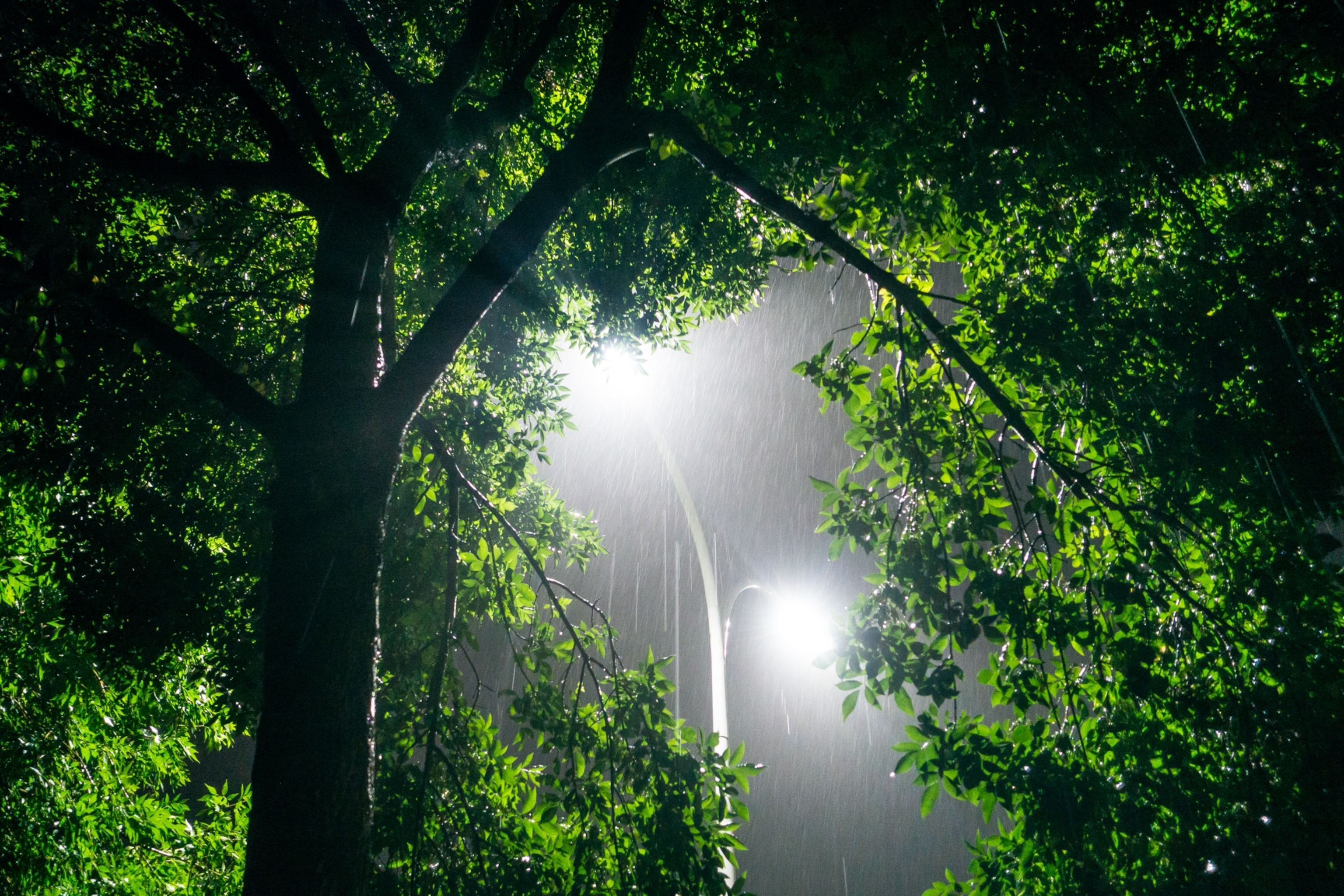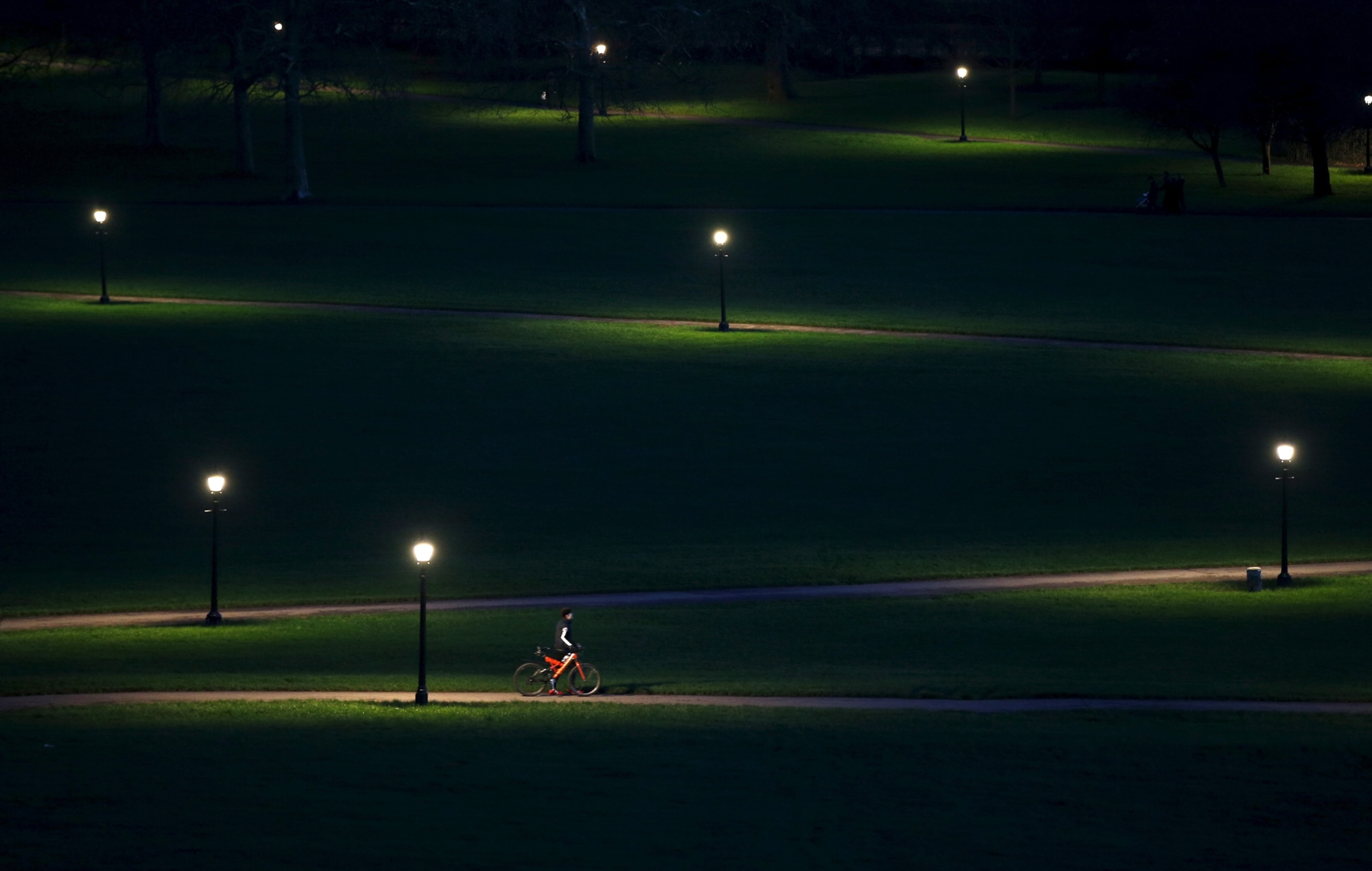Streetlights are influencing nature—from how leaves grow to how insects eat
The steady glow from streetlights is changing the texture of tree leaves, making them less appetizing to insects, according to new research from China.

Light pollution has increased about 10 percent each year over the past decade, making it one of the most drastic changes humans have made to the environment—and insects worldwide are noticing.
Artificial lights that run all night, like streetlights, can make leaves grow tougher and less appetizing for insects, according to new research in Frontiers in Plant Science. This change to photosynthesis could threaten the small food chains that exist within cities.
Taking a closer look at well-lit leaves
Nighttime artificial light affects wildlife throughout the world, with studies showing it skews animals’ circadian rhythms, interferes with amphibian reproduction, confuses sea turtle hatchlings searching for the moon, and throws migrating birds off course.
Insects behave differently when there’s light at night: artificial light hinders firefly communication and reproduction, and some insects may become more visible to predators like bats, or be attracted to lights that can kill them.
Researchers based at the Chinese Academy of Sciences were curious about how light might affect relationships between insects and plants. They noticed tree leaves in cities typically showed fewer signs of insect damage than those outside of cities, so they analyzed leaf samples from trees throughout Beijing.

Focusing on two common street trees—the Japanese pagoda and green ash tree—at 30 sites spaced apart among main roads illuminated at night, the researchers measured brightness and collected leaves. They evaluated almost 5,500 leaves for size, toughness, and levels of nutrients and chemicals, and analyzed them for signs of insects.
Examining leaves’ composition and characteristics can tell scientists a lot about how that plant is using resources. Plants grow differently depending on factors in their environment.
“Plants distribute their limited resources (such as nutrients, water, and energy) among various functions like growth, reproduction, and defense,” says Ellen Cieraad, plant ecologist at Nelson Marlborough Institute of Technology in New Zealand, in an email. “Depending on the environment, it makes sense to invest in different types of functions.” If there are a lot of herbivores around, for example, plants may prioritize defending against being eaten—with thorns, unappetizing chemicals, or tougher leaves.
And for both species of trees the researchers studied, more artificial light in a given area meant tougher leaves. And the tougher the leaf, the less evidence of hungry insects. In areas with the most intense light, leaves were more likely have no signs of insect predation.

What do tougher leaves mean for urban environments?
While the researchers from the new study don’t fully understand why plants are reacting to streetlights in this way, they hypothesize that trees under artificial light at night might be extending their photosynthesis cycle. Since plants use light for growth, explains Shuang Zhang, biologist at the Chinese Academy of Sciences and author of the paper, artificial night light could be unnaturally increasing the time trees spend on photosynthesis.
Scientists don’t fully understand how plants will respond and adapt to the change, says Cieraad.
The type of light also affects how plants use resources: for example absorbing the red light from sunlight can make plants develop tougher leaves, says Cieraad, but these mechanisms probably work differently for artificial red light at night. So something about Beijing’s streetlights could be making the trees in this new study allocate more resources to chemical compounds that make leaves tougher.
This research needs to be expanded to other plant species, says Zhang. “If artificial light at night also makes the leaves of other species tougher, this would be bad news for insects,” says Zhang.
Changes in plants, and in interactions between plants and animals, can significantly impact the entire urban ecosystem.
A poor diet might cause herbivorous insects die off, resulting in fewer insects that eat those herbivorous insects, and fewer insect-eating birds, and so on up the food chain.
Beyond forming a crucial link in food webs, herbivorous insects are sometimes pollinators and contribute to biodiversity. They also eat decaying plants, helping to break down leaves and returning nutrients to soil. In cities, healthy soil and healthy plant life supported by insects are good for humans. Plants in cities provide shade and mitigate heat trapped in cities.
To minimize the negative impacts of light at night, Zhang recommends simply reducing light intensity. The study found a linear relationship between brightness at night and how much leaves were eaten by insects, so just reducing light intensity could make leaves more appealing to insects.
In cities we should focus on only lighting what and when it is needed, says Cieraad. Motion sensors could also help, as could shields for streetlights so light doesn’t spill into surrounding areas.
At home, biologists recommend turning off lights that aren’t needed at night, using motion activated lights, choosing fixtures that direct light only where it’s needed, and using amber-colored lights near homes which appear to be the safest for insects.
Related Topics
You May Also Like
Go Further
Animals
- This Ecuadorian frog was lost for 100 years—until nowThis Ecuadorian frog was lost for 100 years—until now
- We now know why Florida fish spin in circles until they dieWe now know why Florida fish spin in circles until they die
- 5 clever animals that treat and prevent their own illnesses5 clever animals that treat and prevent their own illnesses
- What would the world look like without mosquitoes?What would the world look like without mosquitoes?
- Social media loves to villainize dolphins. Here's why it's wrong.Social media loves to villainize dolphins. Here's why it's wrong.
Environment
- This little bird tells the story of the East Coast’s disappearing marshesThis little bird tells the story of the East Coast’s disappearing marshes
- ‘Corn sweat’—and other weird weather phenomena—explained‘Corn sweat’—and other weird weather phenomena—explained
History & Culture
- Everything you need to know about Hispanic Heritage MonthEverything you need to know about Hispanic Heritage Month
- Your favorite foods have surprising global originsYour favorite foods have surprising global origins
- How did ancient Egyptian obelisks end up all over the world?How did ancient Egyptian obelisks end up all over the world?
- What we’ve learned—and lost—since the Titanic wreck was foundWhat we’ve learned—and lost—since the Titanic wreck was found
- Did Babe Ruth really ‘call’ this legendary home run?Did Babe Ruth really ‘call’ this legendary home run?
Science
- This Ecuadorian frog was lost for 100 years—until nowThis Ecuadorian frog was lost for 100 years—until now
- How much fiber do you need to reduce your cancer risk?How much fiber do you need to reduce your cancer risk?
- Experts explain what drives hair loss and how to fix itExperts explain what drives hair loss and how to fix it
- 8 things we’ve learned about how alcohol harms the body8 things we’ve learned about how alcohol harms the body
Travel
- Here’s how to hike responsibly in Hawaii, according to native HawaiiansHere’s how to hike responsibly in Hawaii, according to native Hawaiians
- Summer doesn’t have to end yet with these fall getawaysSummer doesn’t have to end yet with these fall getaways
- Fall is the best time to visit these 10 national parksFall is the best time to visit these 10 national parks




